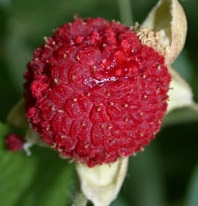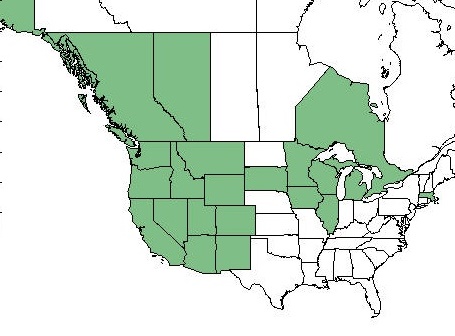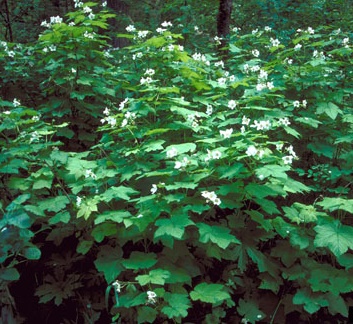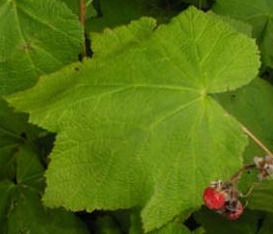Looking for Thimbleberry Facts and Picking Tips in 2024? Scroll down this page and follow the links. And if you bring home some fruit or vegetables and want to can, freeze, make jam, salsa or pickles, see this page for simple, reliable, illustrated canning, freezing or preserving directions. There are plenty of other related resources, click on the resources dropdown above. If you are having a hard time finding canning lids, I've used these, and they're a great price & ship in 2 days.
If you have questions or feedback, please let me know! There are affiliate links on this page. Read our disclosure policy to learn more.
Thimbleberry Facts and Picking Tips
 Thimbleberry Facts and Picking Tips
Thimbleberry Facts and Picking Tips
Thimbleberries ((Rubus parviflorus) are a berry, similar to a raspberry but smaller, with smaller and with more numerous druplets.
Like raspberries, thimbleberries are eaten raw, or cooked and made into jam or jelly and other food items, like muffins, cobblers, etc. They are more tart than raspberries, but are also red when ripe.
Where to find thimbleberries
Thimbleberries are native to Alaska, the western U.S. upper Midwest, and portions of Canada. See the map at right from the U.S.D.A. U.S. Forest Service. Just like raspberries, they are found in the wild in shady, moist areas, and have stems that are similar. you will also find them alongside roads, by stream banks, growing on fences, trees, telephone poles, and in the woods.
How to recognize Thimbleberry plants
While the berry looks much like a raspberry, the plants look more like a wild grape vine than a raspberry. The stem is woody, like a grapevine, and equally thornless, and their leaf is a 5 lobed leaf that looks much more like a grape leaf.
When are Thimbleberries available?
Thimbleberries produce flowers in June and July, so the berries ripen
continuously from late June through August but only a few ripe berries
are usually present on any present on any given bush at any one time. 
Thimbleberry Facts
- Thimbleberries are a very healthy food; packed with anthocyanins!
- About 1/3 lb of thimbleberries make one eight-ounce jar of jam (using sugar as the sweetener)
- Thimbleberries contain more vitamin C than oranges, are super high in fiber, have a good amount of folic acid, are high in potassium, vitamin A and calcium.
- Select plump, firm, fully thimbleberries. Unripe berries will not ripen once picked.
- Thimbleberries belong to a large group of fruits known as brambles, such as blackberries, in the plant genus Rubus.
- Bumblebees, honeybees, and other wild bees love to visit brambles.
- Do the math and be careful not to over-pick as berries quickly mold when left at room temperature, and only last a couple of days in the refrigerator.
- You can easily freeze berries that you cannot use right away - just wash, cut the hulls off and pop them into a ziplock bag, removing as much air as possible. Those vacuum food sealers REALLY do a good job of this! The berries will keep for many months frozen without air.
- I am not aware of any Thimbleberry festivals, but if you want to go to a raspberry festival, See this page for a list!
Before you go to pick:
- If it is a farm, always call before you go to the farm to be sure they are available. If it is in a state or national forest, call the local ranger office to be sure that you may pick, learn of any local hazards (flash floods, poison ivy, bugs, etc.) and ask if they know when they are ripe!
- Leave early. Much nicer picking in the cool of the morning.!
- Bring your own containers, but remember that heaping thimbleberries more than 5 inches deep will bruise the lower berries. Plastic dishpans, metal oven pans with 3 inch tall sides and large pots make good containers. I like the Glad storage containers like the one at right.
- Bring something to drink and a few snacks; you'd be surprised how you can work up a thirst and appetite! And don't forget hats and sunscreen for the sun. Bugs usually aren't a problem, but some deet might be good to bring along if it has been rainy.
Tips on how to pick thimbleberries
- A ripe thimbleberry is deep color with a
plump, soft but firm feel. It will pull free from the plant with only a slight tug. The
center will remain on the plant. Keep in mind, thimbleberries come
in many colors: red, yellow, black, purple, so you want to pick the darker shade of whichever it is.
- Pick only the berries that are fully ripe. Reach in between the stems to grab for hidden berries ready for harvest. Bend down and look up into the plant and you will find loads of berries that other people missed!
- I find it helps to hold the stem with one hand, while picking with the other.
- Repeat these operations using both hands until each holds 3 or 4 berries. Repeat the picking process with both hands.
- Don't overfill your containers or try to pack the berries down. Ideally, the collection containers should be wide so the berries aren't more than a few deep.
- Pick berries into a shallow container. If they get piled too deep they will crush each other.
- Avoid placing the picked berries in the sunlight any longer than necessary. It is better to put them in the shade of a tree or shed than in the car trunk or on the car seat. Cool them as soon as possible after picking.
When you get home
- DON'T wash the berries until you are ready to use them or freeze them. Washing makes them more prone to spoiling.
- DO refrigerate! Right after picking, place raspberries in the fridge. If your fridge tends to dry out produce, lightly cover the container.
- Thimbleberries don't store for very long, usually just a few days. The reason the ones from the grocery store last longer is they are covered with fungicides!
- Pour them out into shallow pans and remove any mushed, soft or rotting berries
- Put a couple of days supply into the fridge, wash off the others, drain them and freeze them up! (Unless you're going to make jam right away) raspberries are less perishable than blueberries or strawberries, but refrigerate them as soon as possible after picking. Temperatures between 34 F and 38 F are best, but, be careful not to freeze the raspberries (while they are in the fridge)!
- Even under ideal conditions raspberries will only keep for a week in a refrigerator, so for best flavor and texture, use them as soon as possible after purchase
- See this page for illustrated freezing instructions.
Thimbleberry Recipes
Thimbleberries cook up just like raspberries, so these raspberry recipes will work fine! One difference is that thimbleberries usually contain high amounts of natural pectin, so you should be able to cut the amount of pectin in half or even eliminate it. Since this is a wild crop, which can vary a lot, it is trial and error.
- Now, get ready to make thimbleberry jam - It is VERY easy - especially
with our free
raspberry jam directions - very easy! or for a jam with a little kick, try raspberry chipotle jam - And if you want to freeze them to use later, see my How to freeze berries page.
- You can also make your own raspberry vinaigrette,
- See this page for an easy recipe to make raspberry chipotle sauce
Frequently Asked Questions and Answers About raspberries
- How to freeze thimbleberries?
First, rinse them in cold water. I use a large bowl filled with water, pour the berries in, and gently stir them with my fingers to dislodge any dirt or bugs. Then using my fingers like a sieve, I scoop the raspberries out of the water, and put them in a drainer to let the water drain off. Then I just pour the berries into a Ziploc bags or vacuum sealer bags and pop them in the freezer. After they are frozen, I remove as much air from the bag as possible and seal the bag.
See this page for illustrated freezing instructions. - II have picked my thimbleberries and have seen little worms. Not sure if
these are fruit flies that have laid eggs in them - or if they are grubs. I
picked some out than froze the berries. I have heard that cold will kill
them or drawn them out. If I make jam the cooked way (not freezer jam) and
some of the grubs/worms are left will it hurt people? I would like to
believe I got them all but fear I did not.
Answer: That sounds like SWD, spotted wing drosophila, the grub or larval form of a fly. Typically, they are about 1/4-inch long. Soaking for an hour or more in salt water (1 cup of slat to the gallon), may help draw them out. Cold would probably kill them, but leave them inside the fruit. I don't imagine they would be harmful if cooked into jam... but I doubt anyone would ask for seconds if they found one. Eeeewwwwww! - See this page about Spotted Wind Drosophila, identification and controls
References
- U.S. Forestry Service
- The business of Thimbleberry jam in Michigan
- US Agricultural Census
- University of Minnesota Extension
- University of Illinois Extension
- AGMR.org
- USDA Ag census Fruits, Tree Nuts, and Berries
- USDA - search USDA raspberries
- NC State University Extension
- The Telegraph
Canning booksCanning & Preserving for Dummies by Karen Ward Get Canning and Preserving For Dummies |
|
The All New Ball Book Of Canning And Preserving: Over 350 of the Best Canned, Jammed, Pickled, and Preserved Recipes PaperbackThis is THE book on canning! My grandmother used this book when I was a child. It tells you in simple instructions how to can almost anything; complete with recipes for jam, jellies, pickles, sauces, canning vegetables, meats, etc. If it can be canned, this book likely tells you how! Click on the link below for more information and / or to buy (no obligation to buy) Click here for more information about the Ball Blue Book of Preserving |
Looking for canning equipment and supplies?
Water bath canner with a jar rack
Pressure canners for gas, electric and induction stoves: Presto 23Qt or T-fal 22Qt
Canning scoop (this one is PERFECT)
Ball Blue book (most recent version)
Jars: 8oz canning jars for jams
Find Other types of farms:
Farm markets and roadside stands
Road trips and camping resources
Local Honey, apiaries, beekeepers
Consumer fraud and scams information
Home canning supplies at the best prices on the internet!
Maple Syrup Farms, sugarworks, maple syrup festivals
Environmental information and resources
Farms For Your Event for birthday parties, weddings, receptions, business meetings, retreats, etc.
Festivals - local fruit and vegetable festivals
Get the
most recent version of
the Ball Blue Book
With this Presto 23 quart pressure canner and pressure cooker, you can "can" everything, fruits, vegetables, jams, jellies, salsa, applesauce, pickles, even meats, soups, stews. Model 01781

You can make jams, jellies, can fruit, applesauce, salsa and pickles with water bath canners, like this Granite Ware 12-Piece Canner Kit, Jar Rack, Blancher, Colander and 5 piece Canning Tool Set

